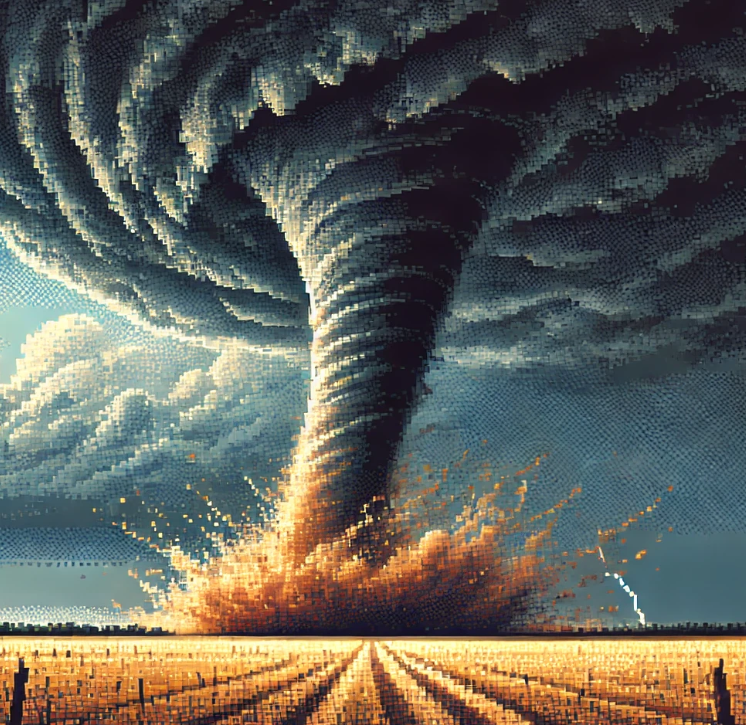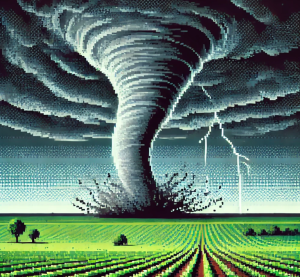
Uncovering the True Frequency of U.S. Tornadoes
Yes, we’ve timed this post to Twisters. I hope to get to go see it with my boys within the next few days.
When you think of tornadoes, you might picture the swirling, destructive funnels tearing through cities or farmlands, often followed by news reports detailing the damage. However, what if I told you that many tornadoes go unreported or are underestimated in their intensity? A recent study sheds light on this hidden world of tornadoes, revealing crucial insights that could reshape our understanding of these natural phenomena.
Tornadoes in the Shadows
Tornadoes are powerful and often unpredictable forces of nature. For years, scientists have suspected that the official tornado records might not tell the whole story. This new study, conducted by researchers from the NOAA National Severe Storms Laboratory and the University of Oklahoma, confirms that suspicion. By using advanced statistical models, they have uncovered significant reporting biases that have led to the underestimation of tornado frequency and intensity.
The Importance of Accurate Tornado Data
Accurate tornado data is vital for several reasons. First, it helps scientists understand how tornadoes form and how they might be influenced by changing climate conditions. Second, it informs public safety measures and building codes designed to protect people and property from tornado damage. Finally, accurate data is essential for economic analyses that assess the costs and benefits of tornado mitigation strategies.
A New Approach to Tornado Reporting
The researchers used a Bayesian hierarchical model to estimate and correct for tornado reporting biases across the central United States from 1975 to 2018. This sophisticated model accounts for factors such as population density, which strongly influences whether a tornado is reported and how accurately its intensity, width, and track length are recorded.
The findings are striking. The model estimates that the actual number of tornadoes, particularly the stronger and wider ones, is significantly higher than what has been recorded. For instance, there may have been three times as many tornadoes capable of causing significant damage (rated EF2 or higher on the Enhanced Fujita scale) than the official records suggest.
Why Are Tornadoes Underreported?
Tornadoes are often underreported or their intensity underrated in sparsely populated areas. This happens because fewer people are around to witness and report them, and there are fewer structures available to assess the damage accurately. As a result, many tornadoes either go unnoticed or are not accurately classified in terms of their strength and size.
The Role of Bayesian Models
Bayesian models are particularly well-suited for this kind of analysis because they can incorporate various sources of uncertainty and prior knowledge into their estimates. In this study, the model adjusted for underreporting by treating it as a function of population density. This approach allowed the researchers to make more accurate estimates of the true number of tornadoes and their characteristics.
Key Findings
- Underreporting of Strong Tornadoes: The model estimates that the actual frequency of stronger tornadoes (EF2 and above) is about three times higher than reported. This suggests a significant underestimation of the potential damage these tornadoes could cause.
- Underestimation of Tornado Width and Track Length: Wider and longer-track tornadoes are also more common than previously thought. The biases in recording these dimensions lead to an incomplete understanding of tornado behavior and risk.
- Stable Tornado Frequency Over Time: Despite these reporting biases, the overall frequency of tornadoes has remained relatively stable over the study period. This finding is important for understanding long-term trends in tornado activity and their potential links to climate change.
Implications for Public Health and Safety
For public health practitioners and researchers, these findings have several important implications. Improved estimates of tornado frequency and intensity can lead to better risk assessments and more effective public safety measures. For instance, emergency management agencies can use this information to enhance tornado warning systems and preparedness plans, potentially saving lives and reducing property damage.
Additionally, this research underscores the need for ongoing improvements in tornado monitoring and reporting. Advances in technology, such as the use of drones and improved radar systems, could help reduce reporting biases and provide a more accurate picture of tornado activity.
Join the Conversation
What are your thoughts on these findings? Do you live in an area prone to tornadoes, and have you experienced one firsthand? Share your stories and thoughts in the comments below or on social media. Here are a couple of questions to get the conversation started:
- Have you ever witnessed a tornado that wasn’t widely reported? How did you learn about it?
- What measures do you think could be taken to improve tornado reporting and ensure more accurate data?
Conclusion
The discovery of underreported and underrated tornadoes challenges our current understanding of tornado activity in the United States. By uncovering these hidden tornadoes, researchers are providing a more accurate and comprehensive view of the risks posed by these powerful storms. This knowledge is crucial for improving public safety measures and preparing for the impacts of future tornadoes.
Join the Science Adventure:
Stay updated with the latest discoveries in science! Our weekly newsletter is perfect for teachers and science enthusiasts. Get the newest research, major breakthroughs, and fascinating stories delivered to your inbox for free. Enhance your teaching and learning. Subscribe today!



